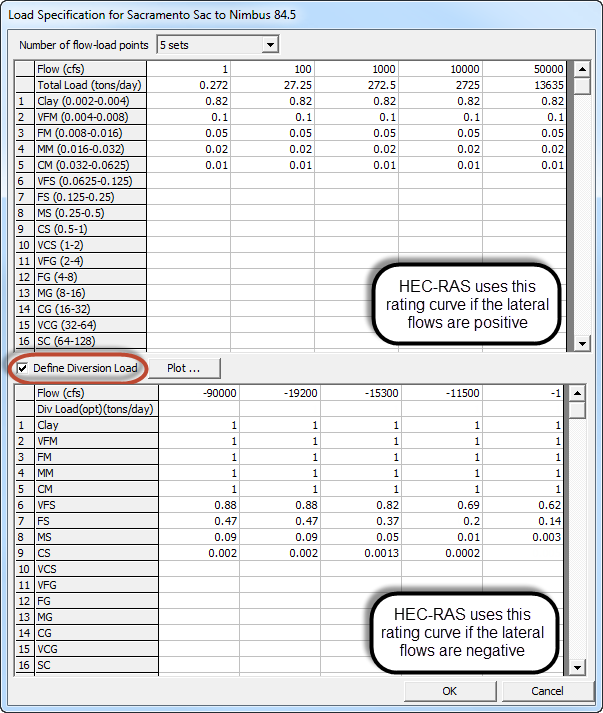Download PDF
Download page Diversion Load.
Diversion Load
Sediment Rating Curves require positive flows and loads. Sometimes lateral flow boundary conditions simulate bidirectional flow, modeling inflows with positive values and abstractions with negative flows. Large weirs in large rivers have been modeled this way in legacy models (e.g. HEC-6T). HEC-RAS computes weir flow and sediment diversion with Lateral Structures. However, sometimes users want more control over diversion assumptions, defining them explicitly with diversion coefficients. This feature should be restricted to lateral flow series.
The Rating Curve option includes a diversion feature that gives users control over diversion mass and gradation. If the lateral flows are positive (into the cross section) HEC-RAS will use the rating curve, but if flows are negative (out of the cross section) the Diversion Rating Curve will control the sediment diverted by grain class.
To define a sediment diversion relationship, specify a sediment rating curve at a cross section with a lateral flow boundary condition and select the Define Diversion Load checkbox. This option expands the editor to include a second rating curve that ties grain class specific diversion data to negative flows (see figure below).
The diversion rating curve will have the same number of flow-load points as the standard rating curve. The user must populate the first row of the diversion data with negative flows that span the range of negative flows expected in the lateral flow series.
Columns: The diversion rating curve columns are coupled to the flow-load curve. The Number of Flow-Load Points drop down box controls both. Both must have the same number of columns.
Flow: Like the rating curve, the diversion curve is tied to flows in the lateral flow series associated with the cross section. However, the diversion curve flows are negative, decreasing (larger negative numbers) from left to right.
Total Load (Optional): By default, the diversion option removes sediment proportional to the diverted flow (e.g. if the lateral flow series removes 10% of the flow, HEC-RAS removes 10% of the sediment). Users can override this default, however, directing the program to remove defined masses for particular flows.
Grain Class Coefficients (the next 20 rows): After HEC-RAS computes the total sediment mass of diverted it subdivides the diverted mass by grain class. The initial gradation of the diverted sediment adopts the gradation of the transported sediment (mass into the control volume). However, diversions do not divert all sediment equally. Finer grain classes, more evenly distributed in the water column, are more likely to divert in proportion to the flow. Coarser materials, concentrated near the bed will divert less sediment than flow and the coarsest grain classes often do not divert at all.

The grain class coefficients apply a screen for each grain class diversion, reducing mass diversion by grain class for these effects. Assign a coefficient of "1" to divert the total computed grain class mass. Coefficients less than one reduce the diverted mass (e.g. 0.35 will only divert 35% of the grain class). Blank or "0" coefficients divert no mass in those grain classes.
Modeling Note: Diversion Relationship Application
The load diversion rating curve either requires copious data with good vertical concentration resolution or analytical estimates (e.g. with a Rouse computation). In general, especially with unsteady sediment transport available in versions since version 5.0, lateral structures can model sediment diversions more directly. Modeling a sediment diversion with a lateral structure will almost certainly be easier, and - unless the project has excellent gradation data of the gradation sediment or high confidence in analytical distributions – may perform comparably.